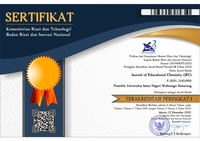Development of Chemistry Flashcard (Chemilard) Based on Augmented Reality in Unity 3D for Chemical Bonding Material
DOI:
https://doi.org/10.21580/jec.2024.6.2.22801Keywords:
augmented reality, chemical bonding, flashcards, learning mediaAbstract
The lack of variety in instructional media can be a starting point for the difficulty in creating an effective and enjoyable learning environment, particularly in chemistry subjects. The concepts in chemical bonding are abstract, making them difficult to apply contextually. Based on these issues, the researchers developed CHEMILARD (Chemistry Flashcard) media using augmented reality. This research employed the D&D (Design and Development) model. The subjects of this study were 6 expert validators in media and content, as well as 25 respondents. The data analysis techniques included Aiken’s analysis and percentage models. The study concluded that the validation of CHEMILARD media, developed across all assessment aspects, indicated that the product is feasible for trial implementation with a score of V=0.90 from media experts and V=0.91 from content experts. The respondents' test results showed an ideal media percentage of 90.3% and an overall media quality rating of 76.72, which is categorized as Very Good. This indicates that the augmented reality-based CHEMILARD media can significantly enhance the learning experience by making abstract chemical bonding concepts more tangible and easier to understand for students.Downloads
References
Bacca, J., Baldiris, S., Fabregat, R., Graf, S., & Kinshuk. (2014). Augmented Reality Trends in Education: A Systematic Review of Research and Applications. Educational Technology & Society, 17(4), 133-149. https://doi.org/10.1111/j.1467-8535.2012.01333.x
Chang, K.-E., Wu, L.-J., & Hsu, C.-T. (2013). Integrating Augmented Reality Technology into Science Education. Educational Technology & Society, 16(3), 69-77.
Dwinata, R. A., Efendi, R., & Yudha, S. P. (2016). Rancang Bangun Aplikasi Tabel Periodik Unsur Dan Perumusan Senyawa Kimia dari Unsur Kimia Dasar Berbasis Android. Jurnal Rekursif, 4(2), 176–183.
Fauziyah, N. (2016). Identifikasi letak kesulitan dan faktor-faktor yang mempengaruhi kesulitan belajkar siswa kelas X IPA SMA Negeri 4 Malang pada materi ikatan kimia [Universitas Negeri Malang].
Hwang, G.-J., Wu, P.-H., & Chen, C.-C. (2015). An Online Game Approach for Improving Students' Learning Performance in Web-Based Problem-Solving Activities. Computers & Education, 59(1), 1246-1256. https://doi.org/10.1016/j.compedu.2012.05.019
Ibáñez, M. B., & Delgado-Kloos, C. (2018). Augmented Reality for STEM Learning: A Systematic Review. Computers & Education, 123, 109-123. https://doi.org/10.1016/j.compedu.2018.05.002
Martin, F., & Betrus, A. K. (2021). Digital Media for Learning: Theories, Processes, and Solutions (1 ed.). Springer Cham. https://doi.org/https://doi.org/10.1007/978-3-030-33120-7
Mat, M. Z. A., Sawari, S. S. M., Nawi, N. M., Junit, F., & Othman, M. M. (2016). An Action Research on the Effectiveness Uses of Flash Card in Promoting Hijaiyah Literacy among Primary School Pupils. Mediterranean Journal of Social Sciences, 7(2), 433–438. https://doi.org/10.5901/mjss.2016.v7n2s1p433
Nurdyansyah. (2019). Media Pembelajaran Inovatif (P. Rais (ed.)). UMSIDA Press.
Nurillah, H. S., & Purwanto, K. K. (2023). Penggunaan Media Augmented Reality Berbasis Android Terhadap Peningkatakan Prestasi Belajar Siswa Pada Materi Ikatan Kimia. UNESA Journal of Chemical Education, 12(1), 17–22.
Ozdemir, S., & Sahin, S. (2018). The Effect of Augmented Reality Applications in the Learning Process: A Meta-Analysis Study. Eurasia Journal of Mathematics, Science and Technology Education, 14(4), 125-131. https://doi.org/10.29333/ejmste/85807
Pramono, A., & Wiratama, F. D. M. (2018). Aplikasi Pengenalan Rumah Adat Indonesia Dengan Konsep 3D-Augmented Reality Berbasis Android. Konvergensi, 14(1), 1–10. https://doi.org/10.30996/konv.v14i1.2766
Rusman. (2013). Belajar dan Pembelajaran Berbasis Komputer. Alfabeta.
Santos, M. E. C., Chen, A., Taketomi, T., Yamamoto, G., Miyazaki, J., & Kato, H. (2014). Augmented Reality Learning Experiences: Survey of Prototype Design and Evaluation. IEEE Transactions on Learning Technologies, 7(1), 38-56. https://doi.org/10.1109/TLT.2013.37
Sukmana, F., & Rozi, F. (2017). Decision support system on computer maintenance management system using Association Rule and Fisher Exact test One Side P-Value. Telkomnika (Telecommunication Computing Electronics and Control), 15(4), 1841–1851. https://doi.org/10.12928/TELKOMNIKA.v15i4.5880
Wu, H.-K., Lee, S. W.-Y., Chang, H.-Y., & Liang, J.-C. (2013). Current Status, Opportunities and Challenges of Augmented Reality in Education. Computers & Education, 62, 41-49. https://doi.org/10.1016/j.compedu.2012.10.024
Downloads
Published
How to Cite
Issue
Section
License
The copyright of the received article shall be assigned to the journal as the publisher of the journal. The intended copyright includes the right to publish the article in various forms (including reprints). The journal maintains the publishing rights to the published articles.
Authors are permitted to disseminate published articles by sharing the link/DOI of the article at the journal. Authors are allowed to use their articles for any legal purposes deemed necessary without written permission from the journal with an acknowledgment of initial publication to this journal.

This work is licensed under a Creative Commons Attribution-NonCommercial-ShareAlike 4.0 International License.


